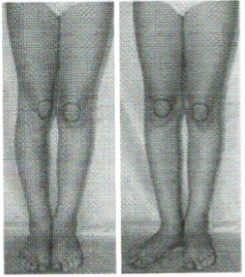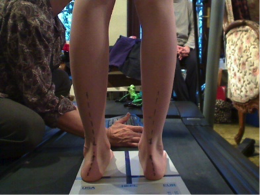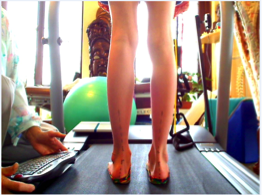Children’s At Home Test
Screening Test A
-

Picture 1 | Picture 2
Look at the front of your child’s legs.
- Draw a circle around the boney outline of the knee cap.
- Ask the child to stand with their feet together (picture #1). NOTE: The knee caps should both ‘point’ in the same direction. The knee caps should be pointing in the same direction as the forward facing of the foot. The two joints function as hinges and the hinges should line up.
- Ask the child to stand with there knee caps facing forward (picture #2). NOTE: the big toe should be pointing in a similar direction as the other side.
If your observations are unquestionable, we strongly recommend that you contact our office and book a Biomechanical Assessment. Read the section on Biomechanics Lab If you are unsure of what you see or would like us to check, contact us TODAY to book a complimentary Children’s Lower Limb Screening Test or to find out more about the foot care and treatment we offer. Ask about our complimentary Foot Posture Screening for adults through to children. ![]()
Screening Test B
- Look at the back of your child’s legs.
- Ask your child to stand with both big toes pointing forward with the feet parallel.
- Draw or look were the line up the back of the heel, achilles tendon and centre of calf should be. This line should be straight from the age of 4-5 years upward.

Picture A – Uncorrected Flat Foot

Picture B – Corrected Flat Feet
Sample profile A & B seen in the same 10 year old female. Note picture #A the line is not straight it sags. Note in picture #B the line up the back of th leg is straight. Picture #A, aesthetiacally this is not pleasant; more importantly ignored this is not good for the growing body and bone built above. Picture #B, the orthotic bespoke orthotic placed under the foot corrects the abnormality (speckled plate seen below the heel). The growth yet to come will be of good quality and shape. This individual after a block of time was able to maintain the good foot posture without the orthotic – changed for life. If your observaitons are unquestionalbe, we strongly recommend that you contact our office and book a Biomechanical Assessment.
Biomechanical Lab
The Biomechanics Lab is the static lower limb assessment test following scientific measure and anatomical normal. At times a gait plate work-up forming part of the Biomechanics Lab is recommended which we will follow with prescription. Special orthotics called gait plates work to correct some of the lower limb dynamics following Wolf’s law and the window of time afforded by the relative malleability through growth plates. Note after a child’s last growth spurt these patterns can only be changed by surgery.
Some helpful tips
Your Posture – the feet should not appear excessively turned out or in, nor should the arch be very flat particularly if the child complains of foot pain or show unusual wear on one or both shoes. Wear may be the first indication that there is a problem with the foot or general posture. This should always be investigated by a qualified and registered podiatrist. Call us to book a foot posture screening for abnormalities including structural or functional issues. If you are unsure of what you see or would like us to check – please contact our office for verification – book a complimentary Children’s Lower Limb Screening Test ![]()


